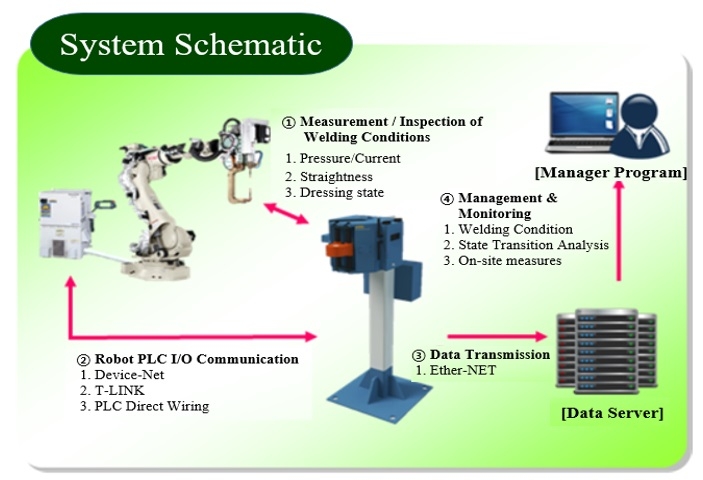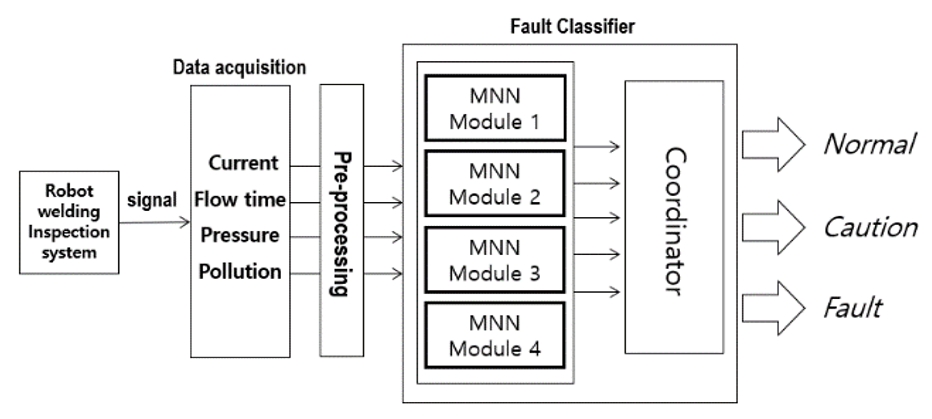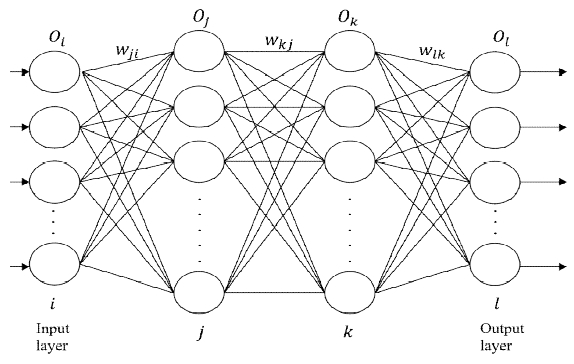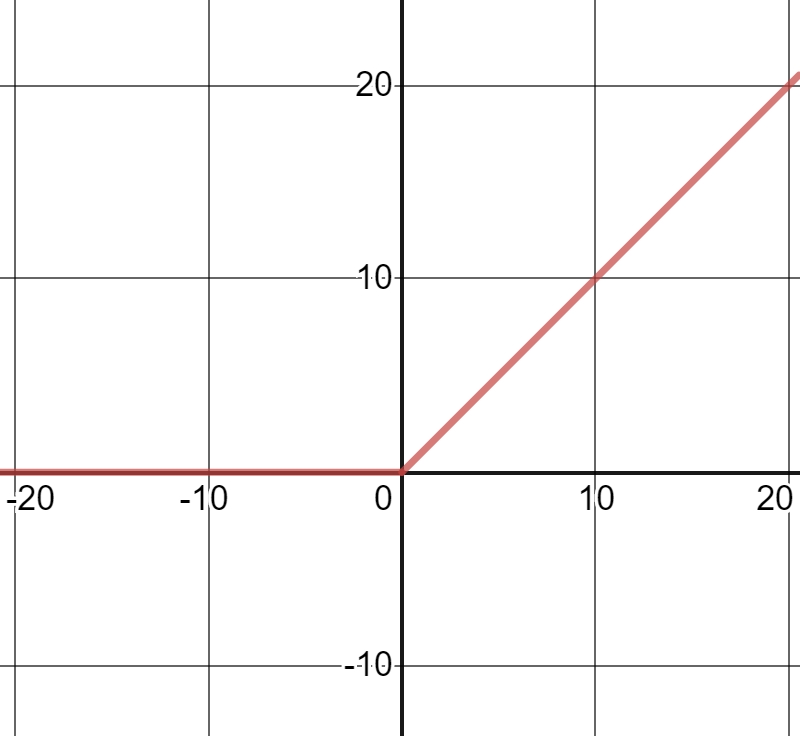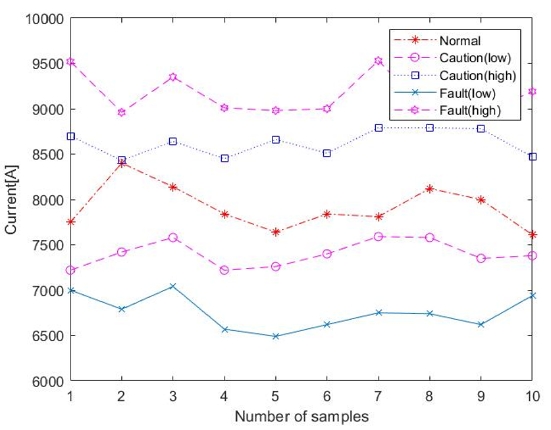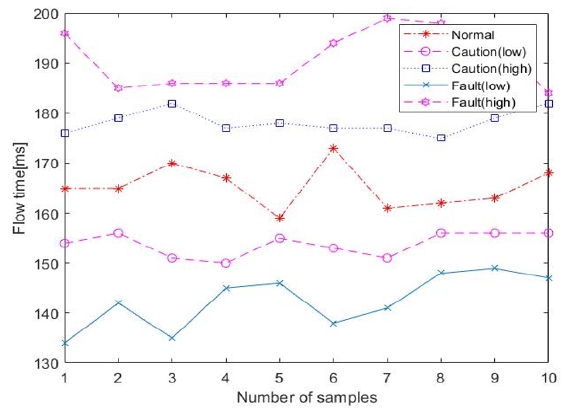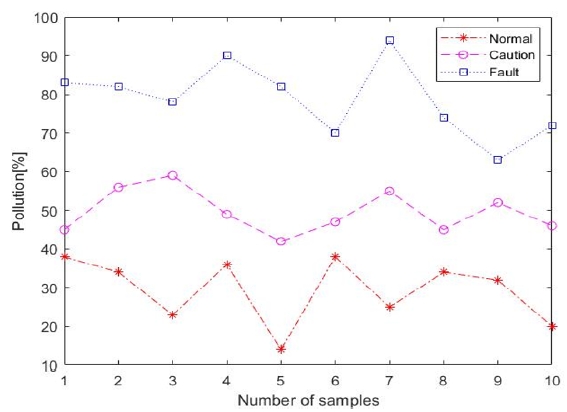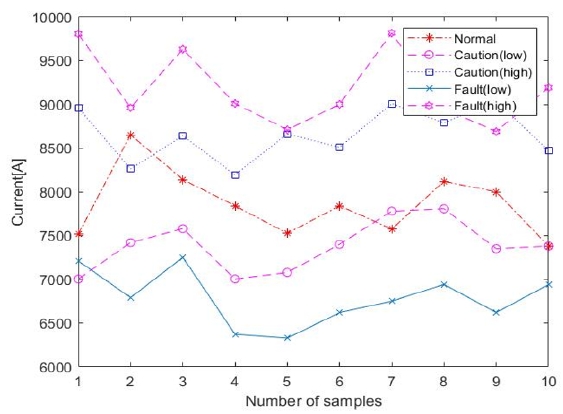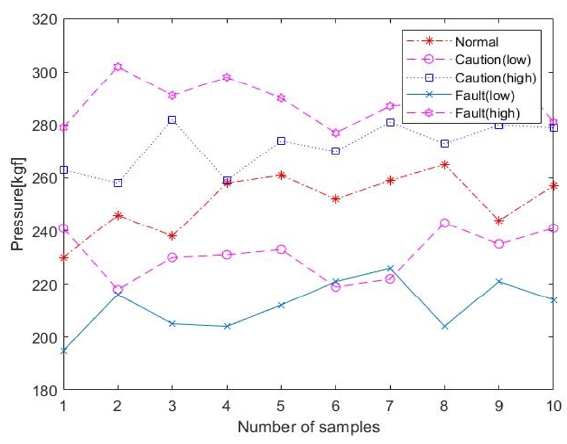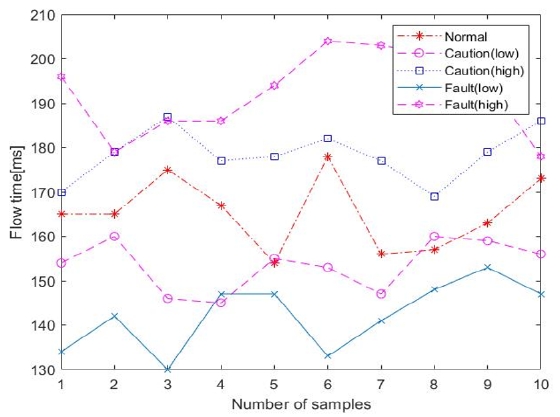
Robot Welding Gun Monitoring System Using Multi-layer Neural Networks
 ; Jong-Hyun Lee*
; Jong-Hyun Lee* ; Tae-Hyun Cho*
; Tae-Hyun Cho* ; Myung-Hwan Jeong**
; Myung-Hwan Jeong** ; Kyung-Jin Na***
; Kyung-Jin Na*** ; Soo-Young Ha***
; Soo-Young Ha***
Abstract
In order to increase the efficiency of the welding process and improve the productivity, it is necessary to develop a fault diagnosis system to monitor the state of the welding gun. In this paper, we propose an aging monitoring and fault diagnosis system for robot welding guns using multi-layer neural network models. In the proposed method, the fault diagnosis of the robot welding gun is performed using the data obtained from the inspection apparatus as the input value of the multi-layer neural network models. We confirmed the accuracy of the system’s fault diagnosis by conducting a simulation using the test data of the current, pressure, flow time, and pollution. In addition, it was confirmed that fault diagnosis can be accurately performed even for a simulation using test data considering noise.
초록
용접 공정의 효율을 높이고 생산성을 향상시키기 위해서는 용접건의 상태를 모니터링 할 수 있는 고장 진단 시스템의 개발이 필요하다. 본 논문에서는 심층 신경회로망 모델을 이용한 로봇 용접건 노후화 모니터링 및 고장 진단 시스템을 제안한다. 제안된 방법에서는 검사 장치에서 획득한 데이터를 심층 신경회로망의 입력 값으로 사용하여 로봇 용접건의 고장 진단을 수행하였다. 고장 진단 시스템의 정확도를 확인하기 위해 전류, 가압력, 통전시간 및 오염도 데이터를 사용하여 시뮬레이션을 진행하였고, 이로부터 시스템의 고장진단의 정확도를 확인하였다. 또한 노이즈를 고려한 테스트 데이터를 사용한 시뮬레이션에서도 고장 진단을 정확하게 수행하는 것을 확인하였다.
Keywords:
robot welding gun, fault diagnosis system, multi-layer neural network, pythonⅠ. Introduction
Until now, the welding gun tip of a welding robot has been replaced when the tip draining test (auto tip dressing, ATD) has been performed 20 times. However, to increase the efficiency of the welding process and improve productivity, it is absolutely required to develop a fault diagnosis system that can automatically predict the state of the welding gun of the welding robot or diagnose faults[1].
Many methods have been proposed to address system fault detection, isolation, and/or compensation problems. Fault detection and isolation (FDI) methods can be categorized into model-based methods and model-free (or nonparametric) approaches[2]. Neural networks (NNs) have proven to be a promising approach for intelligent systems. NNs have been trained to perform complex functions in various fields such as pattern recognition, identification, and classification[3]-[7]. The ability to learn complex nonlinear input–output relationships, the use of sequential training procedures, and their adaptability to data are three outstanding characteristics of NNs. Some popular models of NNs have demonstrated associative memory and the ability to learn[8]-[12]. To enable an NN to efficiently perform a specific classification/clustering task, the learning process updates the network architecture and modifies the weights between neurons. In recent years, neural network (NN) models have also been studied to address FDI[13]-[18]. Some advantages of employing an NN model for fault diagnosis applications include the fact that the system can be efficiently approximated by nonlinear functions, and the system parameters can be updated by adaptive learning and parallel processing.
This paper proposes a robotic welding gun aging monitoring and fault diagnosis system using data obtained from a testing device using the multi-layer neural network models, which is used and has high performance among NN models.
The performance of the proposed method was verified through simulation results using data obtained from the AWIS (Auto Welder Inspection System) welding equipment inspection system as shown in Figs. 1 and 2. The data sets were used for the input value of the multi-layer neural network models.
Ⅱ. Proposed fault diagnosis method
2.1 Multi-layer neural network model-based monitoring system
As shown in Fig. 3, the proposed robot welding gun monitoring system uses the amount of current, pressure, flow time, and pollution by the welding equipment inspection apparatus as the input of each multi-layer neural network (MNN) model modules. The failure diagnosis is performed by measuring the progress of aging of the welding gun and output in five states: normal, caution (lower limit), caution (upper limit), warning (lower limit), and warning (upper limit). The coordinator changes the state of the upper and lower limit to one state when the result of the module is caution (upper-lower limit) and fault (upper-lower limit). In other words, if the result of the module is fault (upper-lower limit), the output state is fault. When the result of the module is normal, the output state is normal.
2.2 Multi-layer neural network model
The multi-layer perceptron model implemented in this study is shown in Fig. 4. The cross-entropy model, which is one of the loss function methods, is used to verify the classification performance of the model. The definition of the cross-entropy error is given by equation (1).
| (1) |
where, tl is given as a one-hot vector as the label value. is the output value of the layer. The cross entropy is used as the loss function in the equation of Di(t) in Eq. (2) and (3).
Optimization is the process of finding a parameter that minimizes the value of the loss function. In this work, the weight update process is performed using the RMSprop optimization function.
RMSprop is a gradient-based optimization algorithm that takes a moving average into exponentially decreasing weights of previous step gradient squares and computes the learning rate to be inversely proportional to the square root of this value. This is shown in equations (2) and (3) [19][20].
| (2) |
| (3) |
where β is the decaying factor and η is the learning rate. Si(t) is the present gradient and is calculated as the exponential average sum of past gradient and gradient variations. Di(t) is . In the MNN model, the neuron adds the bias to the weighted sum of the input and weight values and then determines the output value by the activation function.
The rectified linear unit ReLU function, which is the most frequently used activation function, is used for the two hidden layers. The ReLU function enables simple calculation of the derivative and has the advantage of fast learning speed. The ReLU function is shown in equation (4)[21].
| (4) |
where on is the output value of the n-th node. The graph of equation (4) is shown in Fig 5.
The Softmax function is used for the output layer. Softmax is used to transform the class classification problem, that is, the output from the previous layer, into the probability of each state when solving the state classification problem. The exponent (exp) is taken for each output and divided by the normalization constant so that the sum is 1. as shown in equation (5) and (6)[22][23].
| (5) |
| (6) |
In equation (5), a is the output value that is input from the node of the previous layer to the node of the next layer. i is the index of the node of the previous layer, and j is the index of the node of the next layer. In equation (6), n is the output layer of node. and ai and al are the input value input to nodes of the i and l-th output layers, respectively.
Ⅲ. Simulation and results
The simulation environment was implemented using Python 3.5 and the Keras library on Linux OS. The MNN model used in the experiment consists of an input layer, two hidden layers, and an output layer. The input layer consists of 10 nodes, the two hidden layers consist of 32 nodes, and the output layer consists of 5 nodes. However, the module with input of pollution consists of 3 nodes as the output layer. The reason for this is that the current, pressure and flow time are diagnosed in 5 states, pollution is diagnosed in 3 states. The activation function ReLU was used for optimization in the two hidden layers. The learning rate used in learning was 0.001 and the decaying factor was 0.9.
The inputs were simulated by using the amount of current, pressure, flow time, and pollution obtained from the test equipment as inputs to MNN modules 1, 2, 3, and 4, respectively. The training data used in the simulation included the amount of current, pressure, flow time, and pollution. Each dataset consists of 10 samples. In the learning stage, the data of 40 dataset were used for the current, pressure, and flow time. Whereas the pollution was used 24 dataset.
In Figs. 6-8, the test data of current, pressure and flow time were tested with normal, caution (lower limit), caution (upper limit), fault (lower limit), and fault (upper limit) state. In Fig. 9, the test data of the pollution were tested with normal, caution, and fault state.
Tables 1–4 show the test results for the test data. When generating the result from the module, if the result of the module is normal in the coordinator, the output is the normal state, the output state is Caution for results caution (lower limit) and caution (upper limit), and Fault for results fault (lower limit) and fault (upper limit). Because there are only 3 pollution states, the result of the module in the coordinator becomes the output of the coordinator as is.
The results of the determination of the state of the welding gun show that all the test data exhibited high accuracy and that the state value of the welding gun was accurately determined even at the output part of the coordinator.
Figs. 10–12 show test data randomly considering a noise value of 1~3% in the dataset of the previous Figs. 6–8. Because the dataset of the pollution is not considerably influenced by noise, the dataset of the pollution was not used in this simulation.
The simulation were carried out under the same state except for noise. The results of the simulation are shown in Tables 5–7.
Simulation results show that the test dataset not considering noise yield approximately 1% to 5% more accurate results than the test dataset considering noise. However, the accuracy is still high for the noisy test dataset. It can be seen that the pressure and the flow time have little influence on the accuracy of discrimination between the test data considering noise and test data not considering noise. Therefore, even if noise is generated in the measured data, the monitoring system will be able to accurately determine the state of the welding gun.
Ⅳ. Conclusions
In this paper, we propose an aging monitoring and fault diagnosis system for robot welding guns using an MNN model. In the proposed method, the failure diagnosis of the robot welding gun was performed using the data obtained from the inspection apparatus as the input values of the multi-layer neural network models. Simulation results show that it is possible to determine the state with high accuracy from the data of current, pressure, flow time, and pollution from the inspection apparatus in the welding gun. It was confirmed that the data of current, pressure, flow time, and pollution in consideration of noise can be discriminated without any problem.
It is expected that the proposed monitoring system will be useful for maintenance of equipment because it can predict the failure of a welding gun by verifying and supplementing the performance through the application in a production line.
References
- I. S. Lee, M. H. Jeong, K. H. Kim, and S. Y. Ha, "Development of an Aging Monitoring System for Robotic Welding Gun using ART2 Neural Networks", Proceedings of KIIT Summer Conference, p158-161, Jun. 2016.
-
J. Wagner, and R. Shoureshi, "A Failure Isolation Strategy for Thermofluid System Diagnostics", ASME J. Eng. for Industry, 115(4), p459-465, Nov), (1993.
[https://doi.org/10.1115/1.2901790]

- J. Schurmann, "Pattern classification, a unified view of statistical and neural approaches", John Wiley and Sons, New York, (1996).
-
J. F. Durodola, N. Li, S. Ramachandra, and A. N. Thite, "A pattern recognition artificial neural network method for random fatigue loading life prediction", International Journal of Fatigue, 99, Part 1 p55-67, Jun), (2017.
[https://doi.org/10.1016/j.ijfatigue.2017.02.003]

-
F. Xie, H. Fan, Y. Li, Z. Jiang, R. Meng, and A. Bovik, "Melanoma Classification on Dermoscopy Images Using a Neural Network Ensemble Model", IEEE Transactions on Medical Imaging, 36(3), p849-858, Mar), (2017.
[https://doi.org/10.1109/tmi.2016.2633551]

-
J. Y. Chang, B. J. Lee, S. J. Cho, D. H. Han, and K. H. Lee, "Automatic Classification of Advertising Restaurant Blogs Using Machine Learning Techniques", Journal of IIBC, 16(2), p55-62, Apr), (2016.
[https://doi.org/10.7236/jiibc.2016.16.2.55]

-
M. S. Kang, Y. G. Jung, and D. H. Jang, "A Study on the Search of Optimal Aquaculture farm condition based on Machine Learning", Journal of IIBC, 17(2), p135-140, Apr), (2017.
[https://doi.org/10.7236/jiibc.2017.17.2.135]

- Y. Jiu, L. Wang, Y. Wang, and T. Guo, "A novel memristive Hopfield neural network with application in associative memory", Neurocomputing, 227, p142-148, Mar), (2017.
-
F. Wang, C. Yuanlong, and L. Meichun, "pth moment exponential stability of stochastic memristor-basedbidirectional associative memory (BAM) neural networks with timedelays", Neural Networks, 98, p192-202, Feb), (2018.
[https://doi.org/10.1016/j.neunet.2017.11.007]

- T. Kohonen, "Self-organizing maps", Springer, Berlin, (1997).
- L. Fausett, "Fundamental of neural netwroks", Prentice Hall, (1994).
-
Timmermans, A.J.M, and A.A hulzebosch, "Computer vision system for on-line sorting of pot plants using an artificial neural network classifier", Computer and Electronics in Agriculture, 15(1), p41-55, May), (1996.
[https://doi.org/10.1016/0168-1699(95)00056-9]

-
R. Isermann, "Process Fault Detection Based on Modeling and Estimation Methods-a Survey", Automatica, 20(4), p387-404, Jul), (1984.
[https://doi.org/10.1016/0005-1098(84)90098-0]

- M. M. Polycarpou, and A. T. Vemuri, "Learning Methodology for Failure Detection and Accommodation", IEEE control systems, 15(3), p16-24, Jun), (1995.
- T. Sorsa, H. N. Koivo, and H. Koivisto, "Neural Networks in Process Fault Diagnosis", IEEE transactions on systems, man and cybernetics, 21(4), p815-825, Jul/Aug), (1991.
-
M. A. Kramer, and J. A. Leonard, "Diagnosis Using Back Propagation Neural Networks Analysis and Criticism", Computers & Chemical Engineering, 14(12), p1323-1338, Dec), (1990.
[https://doi.org/10.1016/0098-1354(90)80015-4]

- I. S. Lee, J. T. Kim, J. W. Lee, Y. J. Lee, and K. Y. Kim, "Neural Networks-Based Fault Detection and Isolation of Nonlinear Systems", IASTED International Conference on Neural Networks and Computational Intelligence, Cancun, Mexico, p142-147, May. 2003.
- I. S. Lee, and G. Lee, "Fault Detection and Isolation Using Artificial Neural Networks", Proc. of the ISCA Int’l Conference on Computer Applications in Industry and Engineering, p335-340, Jun. 2006.
- S. M. Ahn, Y. J. Chung, J. J. Lee, and J. H. Yang, "Korean Sentence Generation Using Phoneme-Level LSTM Language Model", Journal of Intelligent Information Systems website, 23(2), p71-88, Jun), (2017.
- http://www.cs.toronto.edu/~tijmen/csc321/slides/lecture_slides_lec6.pdf, [accessed: Oct. 02, 2018]
- Nair, V Hinton, and G. E. Hinton, "Rectified linear units improve restricted boltzmann machines", In Proceedings of the 27th international conference on machine learning (ICML-10), Haifa, Israel, p807-814, Jun. 2010.
- S. Gold, and A. Rangarajan, "Softmax to softassign: Neural network algorithms for combinatorial optimization", Journal of Artificial Neural Networks, p381-399, (1996).
- M. W. Mak, "Lecture Notes on Backpropagation", Technical Report and Lecture Note Series, Department of Electronic and Information Engineering, The Hong Kong Polytechnic University, Jul), (2015.

1986 : BS degrees in Electronic Engineering from Kyungpook National University
1989 : MS degrees in Electronic Engineering from Kyungpook National University
1997 : PhD degrees in Electronic Engineering from Kyungpook National University
1997. 3 ~ 2008. 2 : professor in the School of Electronic and Electrical Engineering at Sangju National University
2005. 8 ~ 2007. 1 : Research scholar at San Diego State University
2008. 3 ~ 2014. 10 : Professor in the Department of Electronic Engineering at Kyungpook National University
2014. 11 ~ now : Professor in the School of Electronics Engineering at Kyungpook National University
Research interests : Fault diagnosis, fault tolerant control, intelligent control using neural networks, battery SOC and SOH
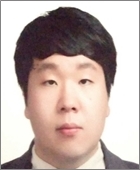
2012. 3 ~ 2018. 2 : BS degrees in Electronic Engineering from Kyungpook National University
2018. 3 ~ now : MS degrees in Electronic Engineering from Kyungpook National University
Research interests : Fault diagnosis, battery SOC and SOH

2013 : BS degrees in Electronic Engineering from Kyungpook National University
2017. 3 ~ 2019. 2 : MS degrees in Electronic Engineering from Kyungpook National University
Research interests : Fault diagnosis, battery SOC and SOH

1989 : BS degrees in Electronic Engineering from Kyungpook National University
1993 : MS degrees in Electronic Engineering from Kyungpook National University
1994. 1 ~ 1999.5 : DAEWOO Electronic Co., LTD
1999. 5 ~ 2014. 4 : Pinetron Co., LTD
2010. 1 ~ now : CTO in the DAEWOO Electronic Components Co., LTD
2014. 4 ~ now : CEO in the AUTO-IT Co., LTD
Research interests : Mobile Security, Smart Factory, Digital Video Recoder, ADAS
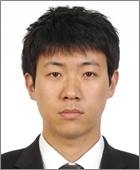
2007 : BS degrees in Major of Computer Control Engineering from Kyungil University
2009 : MS degrees in Electronic Engineering from Kyungpook National University
2009. 3 ~ now : AJIN Industrial Co., LTD
Research interests : Automotive ADAS system, Smart Factory system

1997 : BS degrees in Electronic Engineering from Kumoh National University
1999 : MS degrees in Electronic Engineering from Kyungpook National University
2014 : PhD degrees in Electronic Engineering from Kyungpook National University
1997. 3 ~ 2004. 2 : Engineer in ERC-AC at Seoul National University
2004. 3 ~ now : Team manager in Ajin Industrial Co., Ltd.
Research interests : Autonoums Vehicle, Smart factory, machine vision
